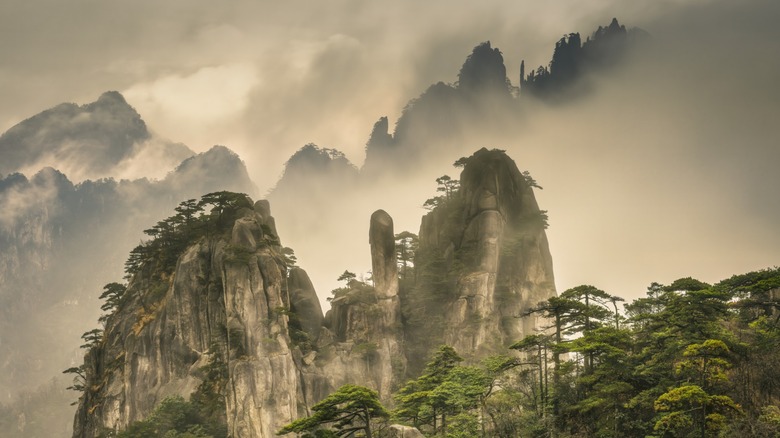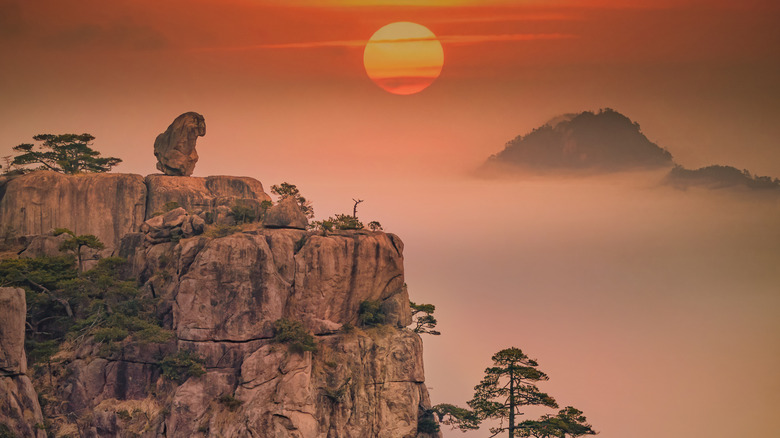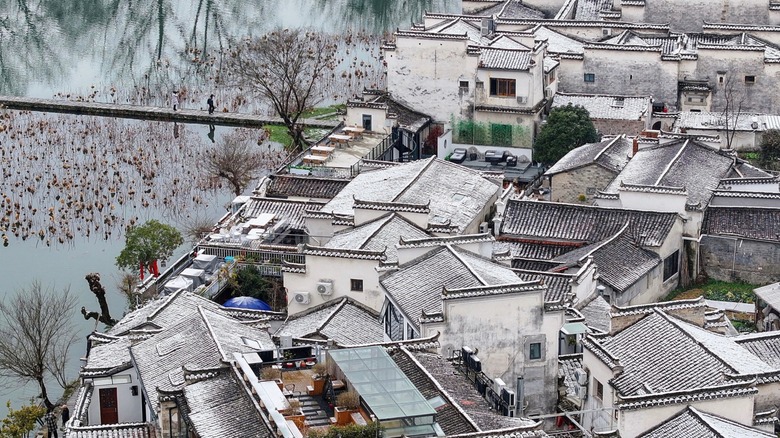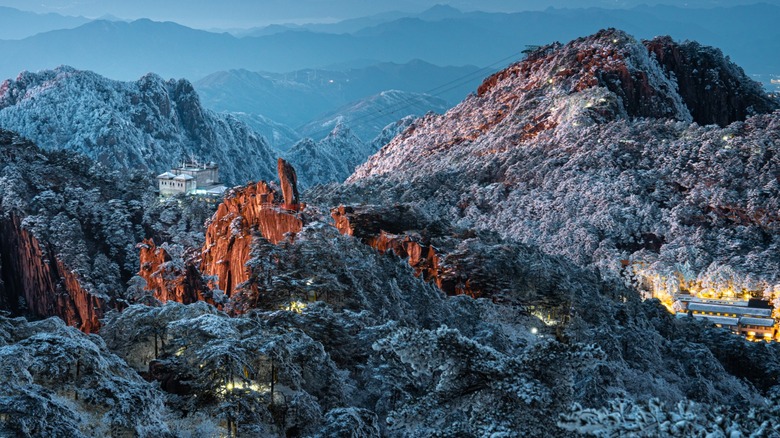Tourists Can Access The Unmatched Views Of 'China's Loveliest Mountain' Thanks To A Scenic Bullet Train
Rising above a sea of clouds in China's eastern Anhui province lies the legendary Mount Huangshan, long described as "China's loveliest mountain." This landscape, filled with majestic peaks, ancient pines, and unique rock formations, has inspired generations of artists and writers — and it has been the subject of many poems, landscape paintings, and other works of art for centuries. It was also supposedly the place where the elixir of immortality was created. Due to its cultural importance, in 1990, Mount Huangshan was designated a UNESCO World Heritage Site for its influential role in Chinese history, literature, and art.
The jagged columns of this mountainscape look similar to those in Zhangjiajie National Forest Park, which represented the massive floating Hallelujah Mountains on the planet Pandora in "Avatar." Indeed, many of Huangshan's steep granite peaks from the Mesozoic era are over 3,000 feet high, with the three tallest ones exceeding 6,000 feet. Emerging through the clouds, and often coated in mist, these dramatic, geological marvels certainly create an otherworldly vision.
Mount Huangshan is located a few hours from the bustling metropolis of Shanghai, a futuristic city filled with extravagant skyscrapers. The name translates to Yellow Mountain, although it's actually a mountain range known as the Yellow Mountains Scenic Area. Be aware that it lies within a city and prefecture of the same name (so this may lead to confusion when you ask for a ticket to "Huangshan"). In the past, visitors had to take an overnight train or fly into the city — meaning that only the most determined of travelers could set their eyes upon these sacred peaks. However, the mountains can now be easily accessed by public transportation — bullet train and bus. Take a scenic ride across a breathtaking landscape to view these extraordinary, Pandora-esque peaks for yourself.
How to experience the Huangshan mountains
The Huangshan mountains consist of 72 peaks, and Lotus Peak — the tallest and most famous — is one of the most spectacular. It is recommended to spend around three to four days in the area, due to the number of trails and the propensity for rain. Three cable cars and one funicular service the area (but two are closed in the winter), and they take passengers partway up and down the mountains. The entrance fee and cable car ticket are purchased separately, and the cost varies depending on the season. You can opt out of the cable car and hike to the summit of Mount Huangshan, but it is a harrowing, multi-day journey of around 60,000 steps. This is not ideal unless you are in peak condition.
From the cable car stations, you can hike to various viewpoints — but arrange which trails you'd like to take in advance, depending on the time you have and the difficulty of the trek. The scenic area is enormous and you won't have time to fit in everything. One that is highly recommended is the Xihai (West Sea) Great Canyon loop trail. From the Xihai funicular station, it takes roughly an hour each way up and down a steep set of stone stairs. But you'll be rewarded with breathtaking vistas of some of the mountain range's most dramatic peaks, which make the strenuous hike worth it.
You can book a group trip of a day or more, where you'll be guided the whole time — or you can opt to tour the area on your own. The trails consist of stairs and paved pathways, so you won't have difficulty finding your way if you go solo. To avoid crowds, do not visit during Chinese holidays or weekends.
Exploring Huangshan and beyond
If you are planning to trek for more than a day, you can stay overnight on the mountain or in the town of Tangkouzhen, located at the base, so that your trip to and from the trails will be short. You'll be close to the Huangshan hot springs too, where you can soak in multiple mineral-rich pools infused with liquids like green tea and coconut milk. This is an excellent way to relieve muscle pain after a long day of trekking. The accommodations in Tangkouzhen are simple and there isn't much to do, so before or after your mountain adventure, ensure that you stay in Huangshan city (also called Tunxi).
Wander down the narrow alleyways of Tunxi Ancient Street to see historic sites, view local artwork, buy handicrafts and souvenirs, and try the best of Anhui cuisine. Visit the ancient villages of Hongcun (pictured above) and Xidi, both UNESCO World Heritage sites whose buildings and Huizhou-style architecture date back to the Song dynasty (A.D. 960 – 1279). Fans of the Oscar-winning "Crouching Tiger, Hidden Dragon" may recognize Hongcun as the setting of the film. This village is arranged in the shape of a lying ox and is filled with ancient dwellings, serene lily ponds, and idyllic stone bridges. Xidi, meanwhile, is surrounded by mountains and has 124 well-preserved buildings from the Ming and Qing dynasties. Hongcun is about 23 miles from Mount Huangshan and 6 miles away from Xidi.
You will also want to spend some time in Shanghai, especially if you plan to take the train from here. There are a plethora of activities and attractions to keep you occupied in this megalopolis before you retreat into the mountains to escape the chaos of the city.
Planning your visit
To get to Huangshan, you can take the bullet train from Shanghai, Nanjing, Beijing, and other cities. From Beijing, the journey is around 6.5 hours. Shanghai is the closest major hub, with several stations to choose from. The trip from Shanghai used to take over 3 hours, but with new lines added to China's expansive train network, you can now reach the city in under 2.5 hours from Shanghai Nan (South) station. You'll arrive in Huangshan North Railway Station (Huangshan Bei), which is 13 miles from the city center. To get to the scenic area, there are bus options from both the train station (50 minutes away) and the city center (1.5 hours away).
You can also fly into Huangshan Tunxi International Airport, which is a 25-minute drive from the city. However, the bullet train is certainly the most exciting, comfortable, and picturesque way to travel. Instead, it is recommended to fly into Shanghai first, as there are direct flights from several U.S. cities — including San Francisco, Los Angeles, and Seattle — to this international hub.
While deciding when you should travel, there are a number of factors to consider. The summer is one of the worst times of year to take a vacation to China, as children have their school vacation during these months and attractions will be packed to the brim. Also, Shanghai in particular is sweltering from June to August, with temperatures soaring to highs of 104° F and humidity reaching 84%. If you're interested in traveling here in the winter, Shanghai is one of the best places in Asia to experience Lunar New Year celebrations. However, note that many businesses in the city will be closed, as locals pack up and travel to their hometowns for the holiday.



